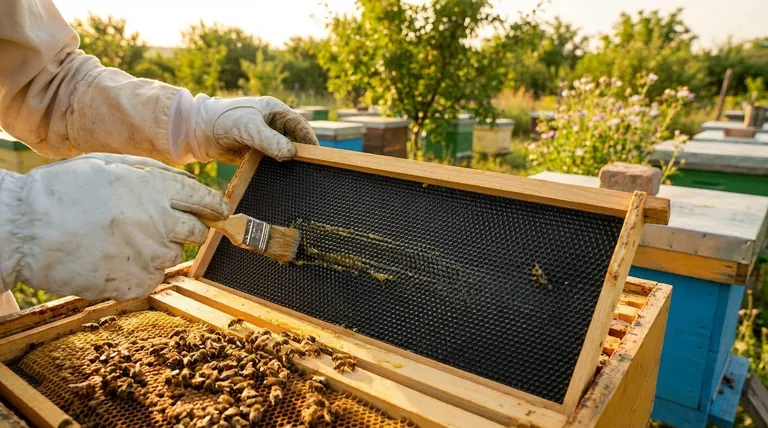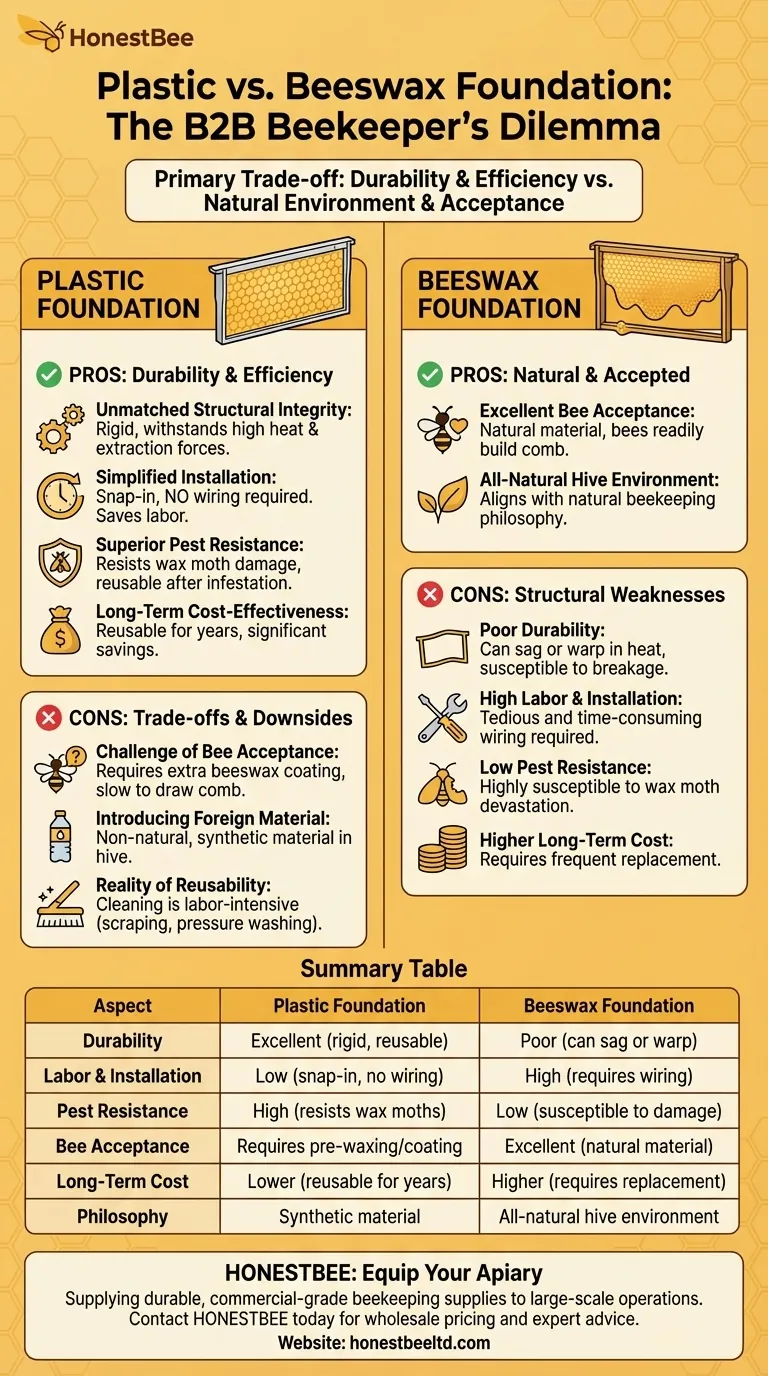The primary trade-off is clear: plastic foundation offers beekeepers unmatched durability, reusability, and operational efficiency. However, these benefits come at the cost of introducing a non-natural material into the hive, which often requires an extra layer of beeswax to ensure the colony accepts it.
The decision between plastic and traditional beeswax foundation is less about which is universally "better" and more about which aligns with your specific beekeeping goals—prioritizing either operational scale and durability or a more natural hive environment.

The Case for Plastic: A Focus on Durability and Efficiency
Plastic foundation has become a staple, particularly in commercial operations, for several practical reasons. Its core advantages solve long-standing problems associated with traditional beeswax foundation.
Unmatched Structural Integrity
Unlike pure beeswax, which can sag or warp in high heat, plastic foundation is rigid and reliable. This structural integrity is crucial during honey extraction, as it withstands the high rotational forces of the extractor without breaking apart.
Simplified Installation and Labor
Plastic foundation is ready to use immediately. It can be snapped into a frame with a grooved top and bottom bar, completely eliminating the tedious and time-consuming process of wiring frames required for beeswax foundation. This significantly reduces labor, a key factor for beekeepers managing many hives.
Superior Pest Resistance
Pests like wax moths can devastate traditional beeswax combs. Plastic foundation is highly resistant to this damage. Even if a frame becomes infested, the plastic base remains intact and can be cleaned and reused, whereas a wax foundation would be completely destroyed.
Long-Term Cost-Effectiveness
While the initial cost may be comparable, the longevity and reusability of plastic foundation lead to significant savings over time. Instead of purchasing new foundation, beekeepers can simply scrape the old comb and wax off, sanitize the plastic, and apply a fresh coat of beeswax for the next season.
Understanding the Trade-offs and Downsides
Despite its practical advantages, plastic foundation is not without its drawbacks. These considerations are critical for making a fully informed decision.
The Challenge of Bee Acceptance
Bees do not naturally build comb on bare plastic. For this reason, plastic foundation almost always comes with a pre-applied layer of beeswax, and many beekeepers add an extra coating of melted beeswax to encourage the bees to draw it out properly. Without a sufficient wax coating, bees may be slow to use the frame or may build irregular, problematic comb.
Introducing a Foreign Material
For beekeepers who adhere to a "natural" philosophy, introducing plastic into the hive is a significant concern. While the plastic itself is generally food-grade, the principle of maintaining a hive free of synthetic materials is a primary reason many choose to stick with traditional beeswax.
The Reality of Reusability
While plastic is durable enough to be reused for many years, the cleaning process is a task in itself. Properly cleaning old frames can involve extensive scraping, pressure washing, and sometimes bleaching to sterilize them. This process can be just as labor-intensive as preparing new frames.
Making the Right Choice for Your Apiary
Your decision should be guided by your operational needs and beekeeping philosophy.
- If your primary focus is efficiency and scale: Plastic foundation is the clear choice for its durability, pest resistance, and reduced labor, making it ideal for commercial or large-scale operations.
- If your primary focus is natural beekeeping: Traditional beeswax foundation is the only option that aligns with the goal of avoiding synthetic materials inside the hive.
- If you are a new beekeeper seeking simplicity: Pre-waxed plastic foundation significantly lowers the barrier to entry by removing the need for wiring frames and providing a durable, forgiving starting point.
Ultimately, choosing the right foundation is about selecting the tool that best serves your individual goals as a beekeeper.
Summary Table:
| Aspect | Plastic Foundation | Beeswax Foundation |
|---|---|---|
| Durability | Excellent (rigid, reusable) | Poor (can sag or warp) |
| Labor & Installation | Low (snap-in, no wiring) | High (requires wiring) |
| Pest Resistance | High (resists wax moths) | Low (susceptible to damage) |
| Bee Acceptance | Requires pre-waxing/coating | Excellent (natural material) |
| Long-Term Cost | Lower (reusable for years) | Higher (requires replacement) |
| Philosophy | Synthetic material | All-natural hive environment |
Ready to Equip Your Apiary with the Right Foundation?
Choosing the right foundation is crucial for the health of your hive and the efficiency of your operation. HONESTBEE supplies durable, commercial-grade beekeeping supplies and equipment to commercial apiaries and beekeeping equipment distributors through our wholesale-focused operations.
We provide the tools that help large-scale beekeepers succeed. Let us help you make the best choice for your goals.
Contact HONESTBEE today for wholesale pricing and expert advice tailored to your commercial needs.
Visual Guide

Related Products
- Food Grade Plastic bee Foundation for Bee Frames
- Beeswax Foundation Sheets Beehive Foundation for Wholesale
- Electric Beeswax Foundation Machine With Operating Tray and Wax Foundation Roller
- Squeezable No-Drip Beehive-Shaped Honey Jars with Flip-Top Cap
- JZBZ Type Wide Base Plastic Queen Cell Cups for Base Mounting and Queen Rearing
People Also Ask
- What additional step can improve the performance of plastic foundation in the hive? Apply a Generous Coat of Beeswax
- Why do commercial beekeepers prefer plastic foundation? Durable, Reusable, and Cost-Effective
- How does plastic foundation differ from beeswax foundation? Choose the Best for Your Hive's Success
- How do you get bees to draw out plastic foundation? Master the Art of Comb Building
- What factors should beekeepers consider when choosing between beeswax and plastic foundation? A Guide to Durability vs. Natural Philosophy













